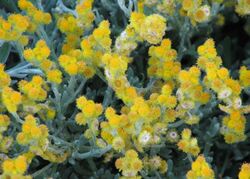Biology:Chrysocephalum apiculatum
| Chrysocephalum apiculatum | |
|---|---|

| |
| Scientific classification | |
| Kingdom: | Plantae |
| Clade: | Tracheophytes |
| Clade: | Angiosperms |
| Clade: | Eudicots |
| Clade: | Asterids |
| Order: | Asterales |
| Family: | Asteraceae |
| Genus: | Chrysocephalum |
| Species: | C. apiculatum
|
| Binomial name | |
| Chrysocephalum apiculatum (Labill.) Steetz
| |
| Synonyms[1] | |
| |
Chrysocephalum apiculatum, known by the common names common everlasting and yellow buttons, is a perennial herb native to southern Australia . It is a member of the Asteraceae, the daisy family. The name "everlasting" was inspired by its use as a long-lasting cut flower. It is increasing in popularity in Australia as a cottage garden plant, but is still not well known.[2]
Description
The common everlasting grows to around 40 centimeters high, with spreading horizontal stems that turn upwards as they get longer. The elongated silvery grey leaves clasp tightly to the stems and are covered in fine, silky hairs. The flower heads are yellow in color and spherical in shape, around 1 centimeter in diameter each, and often borne in clusters.[3] The florets are minute. Like many daisies, it has seeds which are gradually dispersed on the wind. The seed germinates readily, but has a short viable life.
Habitat
The plant grows in full sun on light, well-drained soil in grassy areas. It can tolerate moderately salty wind and dry conditions. Severe pruning will also rejuvenate old plants.[4] It is an important food plant for the Australian painted lady (Vanessa kershawi), a butterfly.[citation needed].
Taxonomy
Chrysocephalum apiculatum was first described as Gnaphalium apiculatum by Jacques Labillardière in 1806,[5][6] but was transferred to the genus, Chrysocephalum, by Joachim Steetz in 1845.[5][7]
References
- ↑ "The Plant List: A Working List of All Plant Species". http://www.theplantlist.org/tpl1.1/record/gcc-105622. Retrieved 20 January 2015.
- ↑ "The Native Plants of Adelaide". Department for Environment and Heritage. Archived from the original on 15 March 2011. https://web.archive.org/web/20110315113933/http://www.slsa.sa.gov.au/site/page.cfm. Retrieved 21 March 2011.
- ↑ Plants of the Adelaide Plains and Hills. Library of South Australia. Accessed 21 March 2011.
- ↑ Scott, Rob; Blake, Neil; Campbell, Jeannie; Evans, Doug; Williams, Nicholas (2002). Indigenous Plants of the Sandbelt A Gardening Guide for South-eastern Melbourne.. Gardners Books. p. 68. ISBN 095810090X.
- ↑ 5.0 5.1 "Chrysocephalum apiculatum". Australian Plant Name Index (APNI), IBIS database. Centre for Plant Biodiversity Research, Australian Government. https://biodiversity.org.au/nsl/services/rest/name/apni/68002.
- ↑ , 2, https://www.biodiversitylibrary.org/page/40881964, Wikidata Q7064396
- ↑ , pp. 474, https://www.biodiversitylibrary.org/page/498647, Wikidata Q109555768
Wikidata ☰ Q5114724 entry
 |

